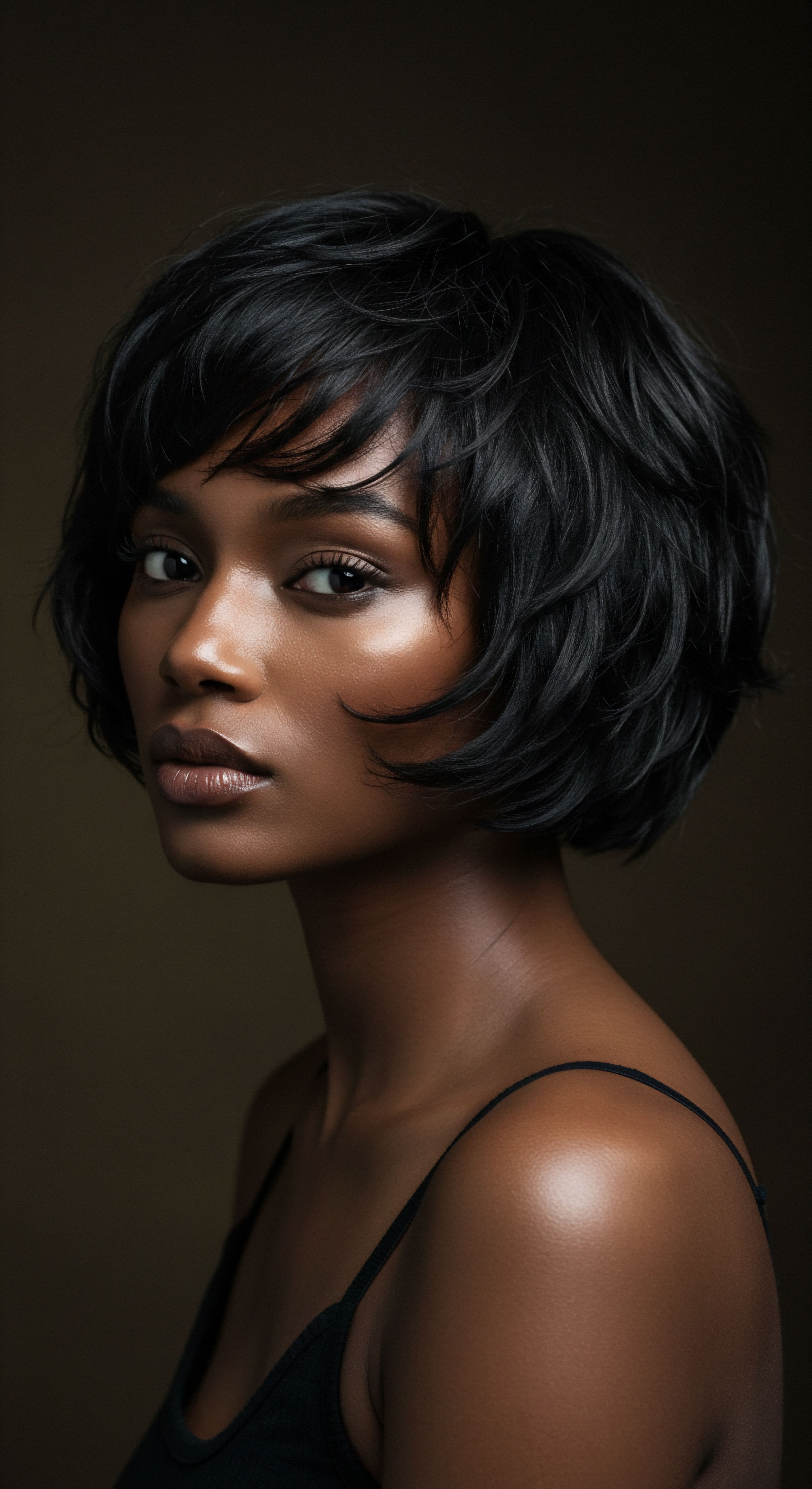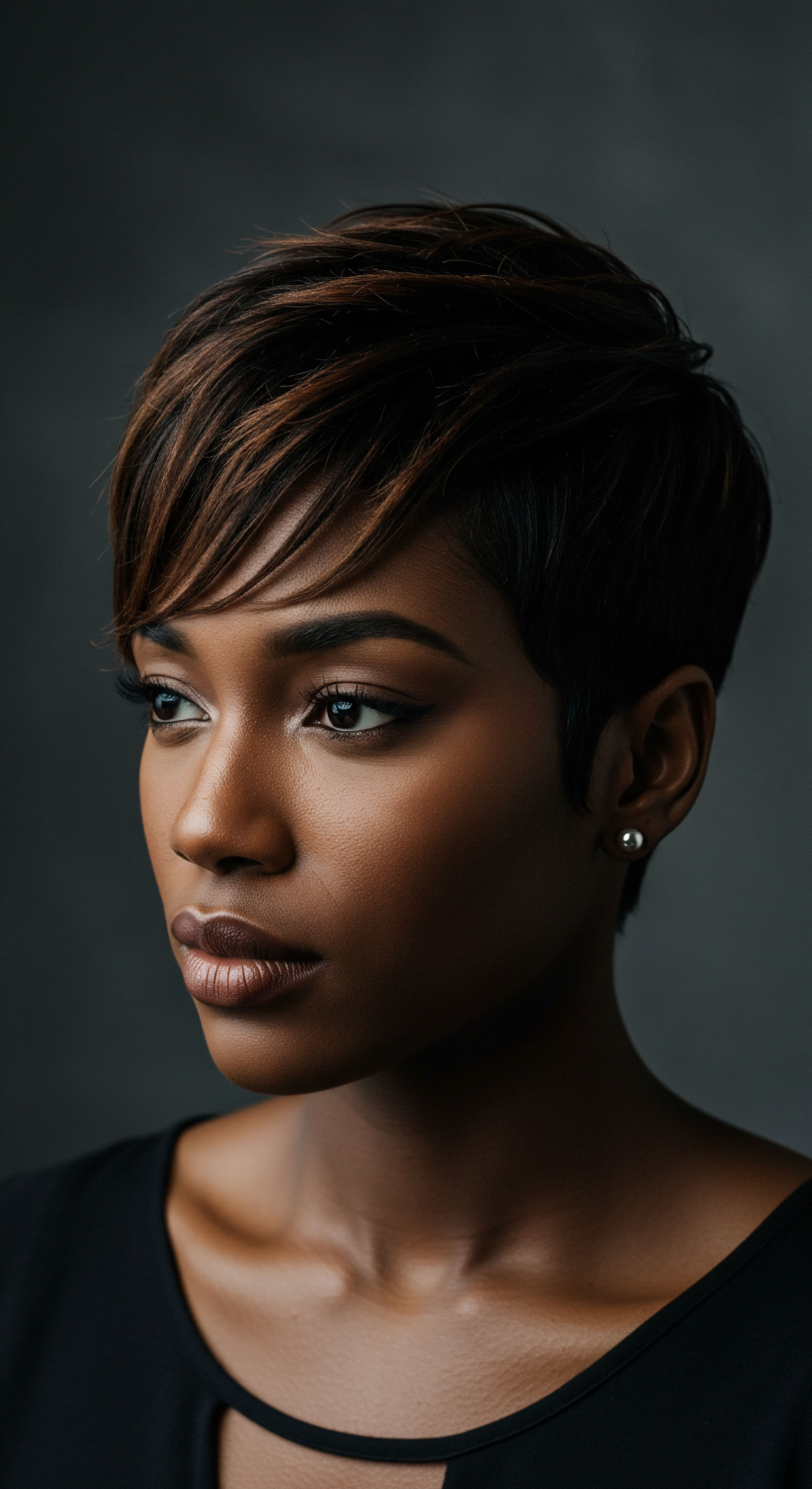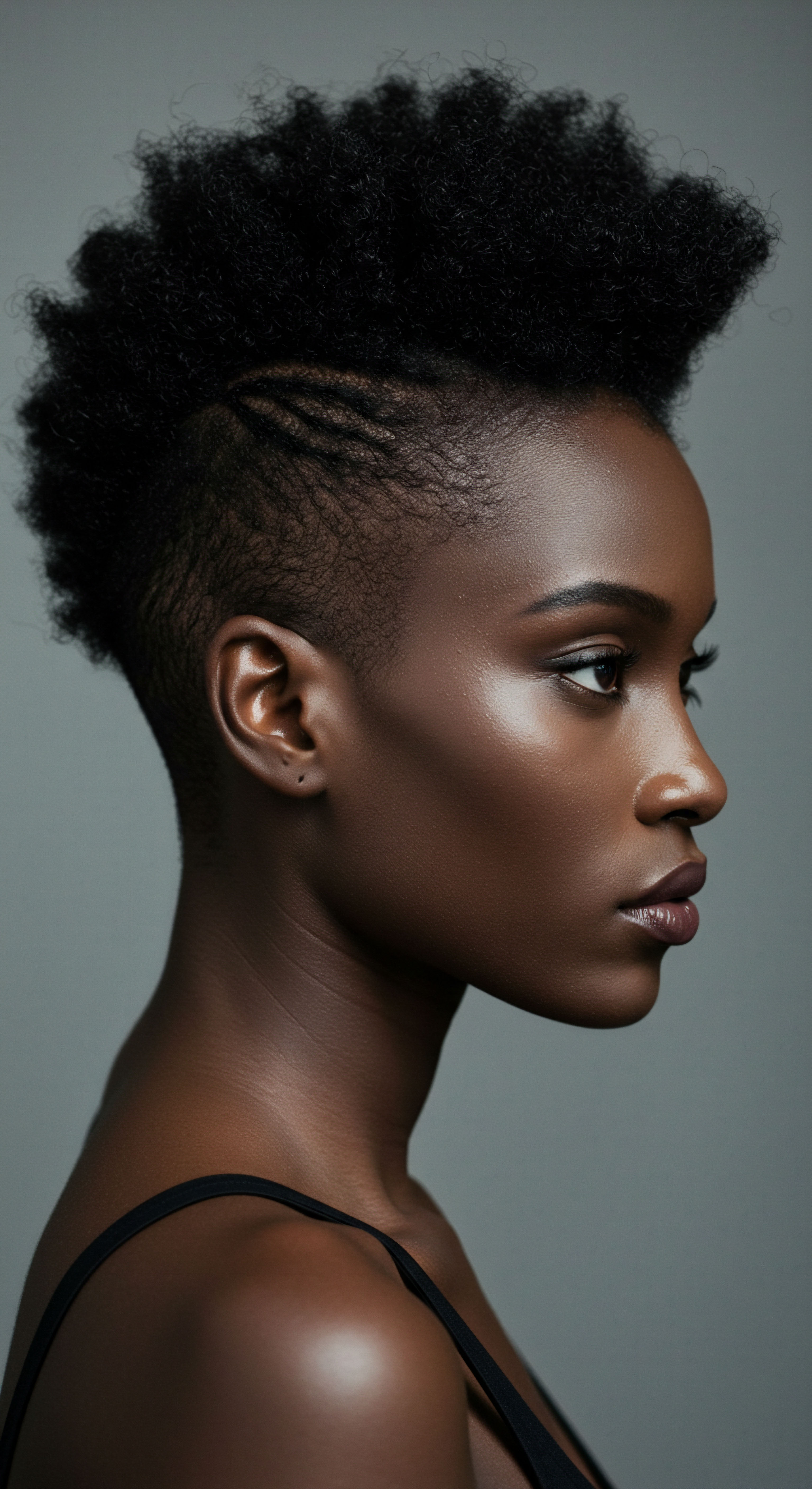
Roots
The very strands that crown us carry echoes of ancestral pathways, whispered tales of trade winds, and the subtle yet profound influence of market rhythms. To truly grasp the essence of hair styles in pre-colonial Africa requires a gentle turning of the gaze towards the economic currents that shaped daily existence. Before the lines of colonial imposition were drawn, societies across the continent navigated a vibrant exchange of goods, services, and ideas. This constant flow, whether of salt across the Sahara, gold from the Akan forests, or intricate textiles along coastal routes, did not merely define prosperity; it subtly, yet undeniably, informed the very aesthetics of personal presentation, particularly the styling of hair.
The materials available, the leisure afforded for creation, and the social hierarchies solidified by wealth all contributed to a visual language spoken through braids, coils, and adornments. Hair, far from being a mere aesthetic choice, became a dynamic ledger, recording economic standing, social role, and communal identity. It was a visible manifestation of resources accumulated, skills honed, and connections forged within complex economic systems.

How Did Resource Availability Influence Hair Styles?
The bounty of the land, or the scarcity of it, held a profound sway over the materials incorporated into hair artistry. Regions rich in specific botanical resources, such as shea butter trees or oil palm groves, found these natural emollients becoming fundamental to hair care and styling. The availability of these ingredients allowed for healthier, more pliable hair, capable of holding intricate shapes and resisting environmental wear. Conversely, areas with fewer natural resources might have seen simpler, more utilitarian styles prevail, or a greater reliance on imported goods if trade networks permitted.
The natural resources available within a community’s economic sphere directly shaped the foundational elements and possibilities for hair care and styling.
Consider the widespread use of natural dyes derived from plants, or the integration of specific fibers for extensions. The economic value of these plants, their cultivation, and their trade routes directly impacted their accessibility and thus their prevalence in hair practices. A community that controlled access to a rare pigment, for instance, might see that color become a symbol of status, worn only by those with the economic means or social standing to acquire it.
- Shea Butter ❉ Its widespread availability in West Africa allowed for rich, nourishing hair treatments, enabling complex styling.
- Palm Oil ❉ A vital economic commodity, palm oil provided conditioning and sheen, impacting the texture and appearance of styles.
- Plant Dyes ❉ Indigenous flora offered pigments, the access to which could signify local economic power or trade connections.

The Economy of Adornment
Beyond the hair itself, the objects woven into it or worn alongside it spoke volumes about economic status. Beads, cowrie shells, metal rings, and precious stones were not simply decorative; they often represented accumulated wealth or access to distant trade networks. The acquisition of these items required economic means, whether through direct purchase, bartering, or inheritance. The rarity of a material, its origin, and the labor involved in its transformation into an adornment all contributed to its economic value and, consequently, its power as a visual marker.
For instance, the use of cowrie shells, a significant form of currency in many parts of pre-colonial Africa, offers a compelling illustration. These shells, not indigenous to the continent, traveled vast distances from the Indian Ocean, making their acquisition a clear indicator of participation in long-distance trade.
| Adornment Type Cowrie Shells |
| Economic Origin/Value Imported currency from Indian Ocean, high value due to rarity and trade routes. |
| Influence on Hair Styles Worn by elite, literal display of wealth woven into braids or attached to coiffures. |
| Adornment Type Glass Beads |
| Economic Origin/Value Often imported, but also locally produced. Value varied by color, size, and origin. |
| Influence on Hair Styles Used for intricate patterns, signifying trade connections and social status. |
| Adornment Type Gold/Copper Alloys |
| Economic Origin/Value Local mining and metallurgy, high labor investment for crafting. |
| Influence on Hair Styles Reserved for royalty or wealthy individuals, signifying power and accumulated resources. |
| Adornment Type Amber/Coral |
| Economic Origin/Value Rare, imported through long-distance trade networks. |
| Influence on Hair Styles Symbols of extreme wealth and access to prestigious trade goods. |

Ritual
Moving beyond the foundational elements, we begin to perceive how the economic pulse of a community shaped the very practices and traditions surrounding hair. It was not simply about what materials were available, but how the structure of society, influenced by its economic underpinnings, allowed for the time, skill, and specialized labor necessary for the creation and maintenance of these intricate styles. The act of styling hair, often a communal or familial affair, was simultaneously a display of social cohesion and an implicit reflection of economic capacity.
The daily or periodic rituals of hair care and styling were not detached from the broader economic landscape. They required time, a resource often dictated by the demands of agriculture, trade, or other livelihoods. Furthermore, the development of specialized roles within communities, such as professional hair stylists or adornment makers, speaks directly to an economic surplus that could support such dedicated craftsmanship.

The Value of Time and Labor in Styling
Many pre-colonial African hairstyles were remarkably complex, requiring hours, sometimes even days, to complete. This investment of time was a significant economic factor. For individuals or families engaged in subsistence farming or demanding trade, dedicating such extensive periods to hair styling was a luxury. Therefore, elaborate coiffures often became associated with those who had the leisure time, or the means to delegate labor, allowing them to participate in these time-intensive beauty rituals.
The ability to afford the labor of a skilled stylist, or to have family members free to dedicate hours to intricate braiding, was a direct indicator of economic standing. In societies where every hand was needed for agricultural work or craft production, the display of complex, time-consuming hairstyles signaled a household that was economically secure enough to spare this valuable resource.

Specialized Craftsmanship and Economic Support
The emergence of specialized hair stylists, barbers, and artisans who crafted hair adornments represents a distinct economic development. These individuals, possessing unique skills, could command payment for their services, whether in goods, livestock, or early forms of currency. Their existence implies a clientele with disposable income or surplus resources willing to invest in aesthetic presentation.
The presence of specialized hair artisans in pre-colonial African societies underscored an economic environment capable of supporting dedicated craftsmanship and valuing aesthetic labor.
In some communities, specific lineages or guilds were responsible for certain crafts, including those related to hair adornment. The economic power and social standing of these groups were directly tied to the demand for their specialized products and services. The training of apprentices, the transmission of knowledge, and the quality of their output were all influenced by the economic incentives and opportunities available within their society.
For instance, the Manding blacksmiths and goldsmiths, celebrated for their metalwork across West Africa, created exquisite hair ornaments from gold, copper, and bronze. These pieces were not merely decorative; they were investments, often passed down through generations, their value intrinsically linked to the economic prowess of the artisans and the patrons who commissioned them. The very existence of such highly skilled, non-agricultural specialists is a testament to an economy robust enough to sustain them.

Trade Routes and the Spread of Styles
Economic trade routes, whether trans-Saharan, coastal, or riverine, were conduits not only for goods but also for cultural exchange, including hair practices. As merchants, artisans, and travelers moved across regions, they carried with them new ideas, materials, and techniques for hair styling. The economic viability of these routes directly influenced the diffusion of styles and the accessibility of foreign adornments.
A well-established trade route could introduce new types of beads, textiles, or even specific tools that would then be incorporated into local hair traditions, often initially by the wealthier members of society who had first access to these imported goods. The economic prosperity of a trading hub, for example, could lead to a greater diversity and sophistication of hairstyles, reflecting its cosmopolitan character and access to a wider array of resources.
- Long-Distance Trade ❉ Facilitated the movement of valuable hair adornments like beads, shells, and metals across vast regions.
- Regional Markets ❉ Allowed for the exchange of local hair care products and styling tools, diversifying options.
- Artisan Mobility ❉ Skilled stylists and craftspeople might travel along trade routes, spreading techniques and creating new economic opportunities.

Relay
The currents of economic life in pre-colonial Africa did more than simply provide materials or dictate time; they sculpted the very symbolism and social coding embedded within hair. To truly appreciate this interplay requires us to move beyond the surface and into the deeper strata where wealth, power, and identity intertwined. Hair became a complex semaphore, broadcasting an individual’s place within the economic hierarchy, their lineage, and their access to resources. This was a sophisticated system of non-verbal communication, where every braid, every adornment, every coiffure, spoke volumes about one’s standing in a dynamic, often competitive, economic landscape.
This section seeks to unearth the more subtle, yet profoundly influential, ways economic factors shaped the very language of hair, exploring how styles became literal investments and how shifts in economic power directly translated into shifts in aesthetic expression. We will examine how the accumulation of wealth, the control of resources, and even the nuances of labor division found their expression in the hair, offering a glimpse into a society where personal presentation was inextricably linked to economic reality.

What Role Did Wealth Accumulation Play in Hair Adornment?
The accumulation of wealth, whether in livestock, agricultural surplus, or trade goods, often found its most public expression through personal adornment, with hair serving as a prominent canvas. The ability to acquire rare, costly, or imported materials for hair decoration was a direct testament to one’s economic standing. This wasn’t merely about displaying riches; it was about solidifying and communicating social position within a community where economic success often correlated with political influence and prestige.
Consider the use of imported beads, particularly Venetian glass beads, which traversed vast distances across the continent. While not indigenous, their presence in various regions through extensive trade networks (often controlled by powerful economic entities) made them highly prized. The sheer quantity, quality, and origin of these beads woven into hairstyles could denote significant wealth. For example, historical accounts and archaeological findings suggest that in some West African societies, the elite would wear hairstyles literally weighted down with valuable beads and metal, signifying their economic prowess.
A study by Dr. John Thornton on the Kongo Kingdom in the 17th century, for instance, details how the ruling class and wealthy merchants would incorporate imported goods, including beads and textiles, into their elaborate hairstyles and clothing. While direct quantitative data on the economic value of specific hairstyles is scarce due to the ephemeral nature of hair and the lack of precise records, the ethnographic and historical accounts consistently link the complexity and material richness of coiffures to social status, which was itself often built upon economic foundations. The more intricate the style, the more precious the adornments, the greater the implied economic backing of the individual or family.

How Did Economic Specialization Influence Hair Styles?
The development of specialized economic roles within pre-colonial African societies, such as those of blacksmiths, weavers, or even professional stylists, had a profound impact on the complexity and artistry of hairstyles. As economies diversified beyond subsistence, certain individuals could dedicate their lives to mastering specific crafts, leading to an elevated level of skill and innovation. This specialization meant that access to the most sophisticated styles often required economic means to commission the work of these skilled practitioners.
For instance, in some West African cultures, barbers were not merely cutters of hair; they were highly respected artists and often confidantes, possessing intimate knowledge of both hair techniques and social customs. Their services were not cheap, and only those with sufficient economic standing could regularly employ them for the elaborate, time-consuming styles that marked high status. The tools they used, often made by specialized metalworkers, also represented an economic investment, further reinforcing the professionalization of hair artistry.
This dynamic created a feedback loop ❉ economic specialization allowed for more intricate and symbolically rich hairstyles, which in turn became more powerful markers of economic and social standing, thus driving further demand for specialized services. The very existence of a “fashion” cycle, where certain styles gained or lost prominence, was underpinned by the economic ability of communities to innovate, adopt, and display these changing aesthetics.

The Interplay of Trade Networks and Hair Aesthetics
The vast and sophisticated trade networks that crisscrossed pre-colonial Africa were not just conduits for goods; they were arteries for cultural exchange, deeply influencing hair aesthetics. The economic power of these networks, and the groups who controlled them, directly shaped the availability of exotic materials that found their way into hair.
Consider the impact of the trans-Saharan trade on West African societies. Gold, salt, and kola nuts moved north, while goods like textiles, glass beads, and cowrie shells flowed south. The acquisition of these imported items, particularly the beads and cowries, often served as a tangible display of wealth and connection to these lucrative trade routes.
A woman wearing a hairstyle adorned with numerous, perfectly formed cowrie shells, for example, was literally displaying her family’s economic ties to the vast mercantile systems that spanned the continent. The value of these shells fluctuated based on supply and demand, making their display a dynamic economic statement.
| Trade Route/Economic Zone Trans-Saharan Trade |
| Key Goods Traded Salt, Gold, Textiles, Glass Beads, Cowrie Shells |
| Impact on Hair Styles/Adornments Introduction of rare, imported beads and shells; styles signifying connection to wealthy trading centers. |
| Trade Route/Economic Zone Coastal Trade (Atlantic/Indian Ocean) |
| Key Goods Traded European goods (cloth, metals), local products (ivory, gold, spices) |
| Impact on Hair Styles/Adornments New forms of metal adornments, colorful fabrics for headwraps, adoption of new tools. |
| Trade Route/Economic Zone Internal Riverine/Forest Trade |
| Key Goods Traded Palm oil, Shea butter, Kola nuts, Local dyes, Specific fibers |
| Impact on Hair Styles/Adornments Availability of natural emollients for hair health, indigenous fibers for extensions, regional stylistic variations. |
The economic success of a trading town or kingdom could be seen in the elaborate hairstyles of its inhabitants, adorned with materials sourced from distant lands, reflecting their participation in a globalized (for its time) economic system. The aesthetic choices were, in many ways, economic choices, reflecting access, power, and prestige.

Reflection
The intricate dance between economic realities and the artistry of hair in pre-colonial Africa offers a profound lesson. It reveals that beauty was rarely a superficial pursuit; it was a deeply embedded expression of identity, status, and survival within a complex web of communal life. The way hair was cared for, styled, and adorned spoke volumes about a society’s resourcefulness, its capacity for specialization, and its connections to wider worlds. These echoes of economic influence remind us that our hair, in all its varied glory, has always carried stories far beyond the aesthetic, serving as a quiet testament to the enduring human spirit shaped by the very currents of life.

References
- Thornton, John. Africa and Africans in the Making of the Atlantic World, 1400-1800. Cambridge University Press, 1998.
- Gale, Robert L. African Hairstyles ❉ Styles of Yesterday and Today. University Press of Mississippi, 1999.
- Spring, Christopher. African Textiles Today. Smithsonian Books, 2012.
- Hrbek, Ivan. Africa from the Seventh to the Eleventh Century. Heinemann, 1992.
- Obenga, Theophile. African Philosophy ❉ The Pharaonic Period ❉ 2780-330 BC. Per Ankh, 1995.
- Coquery-Vidrovitch, Catherine. The History of African Cities South of the Sahara ❉ From the Origins to Colonization. Markus Wiener Publishers, 2005.
- Lovejoy, Paul E. Transformations in Slavery ❉ A History of Slavery in Africa. Cambridge University Press, 2012.
- Phillipson, David W. African Archaeology. Cambridge University Press, 2005.
- Bovill, E. W. The Golden Trade of the Moors. Oxford University Press, 1968.